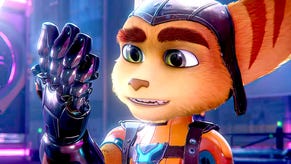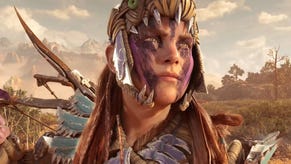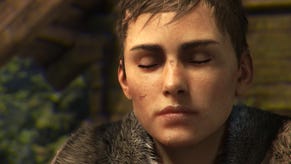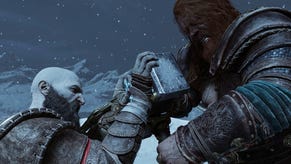What works and what doesn't in Horizon Zero Dawn
Digital Foundry's comprehensive technical breakdown.
Guerrilla Games has long been known for pushing the limits of console technology, but with Horizon Zero Dawn, the Dutch studio reaches new heights. After spending more than ten years immersed in the world of Killzone, Guerrilla has shifted gear with a deep, complex action RPG with perhaps the most impressive visuals yet seen in an open world title. It's a massive shift in focus and a big gamble on the part of the developer. So what works and what doesn't in Horizon Zero Dawn?
At its core, Horizon is built on the Decima engine - the in-house technology Guerrilla has crafted to power its games. The name "Decima" was only revealed when Kojima Productions selected the engine for its upcoming Death Stranding, but the tools and technology have been evolving for years now. Until now, Guerrilla has always focused on building linear action games but the move to an open world required the team to expand the capabilities of the engine to support this new type of design.
It's a profound shift to a more ambitious game model, but the good news is that Decima's visual feature set has expanded since Killzone Shadow Fall - with few compromises. The technology supports a wide range of features including physically-based rendering, an impressive suite of post-processing effects, support for rich animation and an advanced audio sub-system. The presentations given by Guerrilla over the years also paint a picture of a user-friendly development environment, complete with a full node-graph system enabling designers to create advanced behaviours and gameplay concepts with minimal programming experience. As things stand, Decima appears to be one of the most flexible and capable engines in the industry today.
As advanced as the engine may be, staffing up and moving to an entirely new type of game is a challenging endevour. After all, when Naughty Dog jumped from Jak and Daxter to Uncharted, the sheer scale of the move presented many difficulties, to the point where the studio didn't really find its feet until the launch of Uncharted 2: Among Thieves. Has Guerrilla managed a more graceful transition? Has it managed to deliver the fidelity we've come to expect with a much larger scale? What sacrifices were made to reach that goal and what could be improved in a potential sequel?
What works
- The world: From both a technical and artistic perspective, the world of Horizon is a triumph. The sense of scale on display is truly breathtaking and the game is rich in detail. Foliage and rubble pepper the landscape, towering mechanical cities tower in the distance while volumetric lighting hangs gently in the air. This is backed by a remarkable real-time cloud simulation that enables a realistic portrayal of the sky building a more cohesive environment in the process. The way in which these elements complement one another to create such an impressive environment stands out as a remarkable achievement in design.
- Materials: Killzone Shadow Fall was one of the first games this generation to make use of physically-based rendering and Horizon continues that trend with a rich materials system. Horizon combines natural materials such as wood and stone with the ancient technology of the old world to great effect. The machines are decked out in futuristic looking polymers and metal plates which play nicely off the more natural surroundings resulting in a unique looking game. Textures are rich with detail and look great under a variety of lighting conditions.
- Character animation and detail: Open world games sometimes make sacrifices to character detail out of necessity but impressively, Guerrilla manages to maintain a level of quality on par with a linear action game. Textures used on clothing and skin are of high resolution while the applied shading introduces an extra layer of realism. World traversal feels natural thanks to smart design, while inverse kinematics allow Aloy's feet and body to react naturally to the wild undulation of the terrain. The skeleton system from Killzone Shadow Fall makes a return enabling even more robust animation work. Each outfit exhibits bits and bobs which make use of a physics system designed to allow these materials to react naturally while moving. The quality of the models and fluidity of the animation all come together to create a satisfying sensation of movement and interaction which enhances the basic feel of the game - a key element in any third person title.
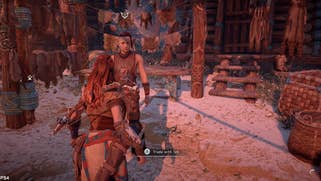
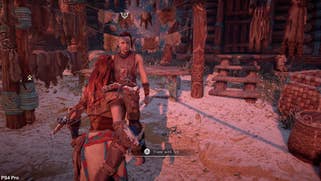

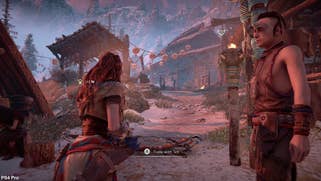
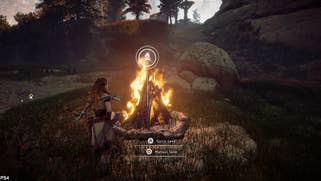
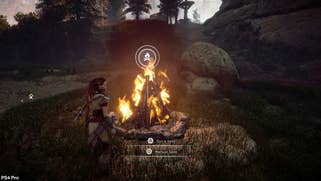
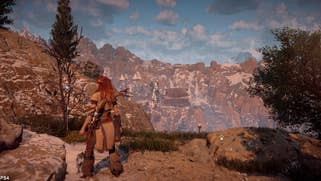
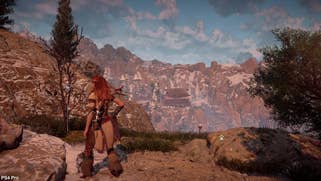
- Post-processing effects: Since Killzone 2, Guerrilla has pushed the envelope in terms of the quality of its post-process pipeline. From motion blur and depth of field to reflections and light blooms, Horizon makes use of the full suite of effects available in Decima. Motion blur is prominent throughout the game and applied to camera and character movement alike. This helps increase the fluidity of animation while emphasising dramatic actions. The effect is beautiful but subtle enough so as not to distract those that don't care for it. A high-quality bokeh depth of field is used both in photo mode and during conversations. The soft-focus effect is striking at times when contrasted against bright backgrounds. Each of these effects combine with one another to create an highly appealing final composition.
- Frame-rate: On the surface, 30 frames per second doesn't sound especially impressive, but reaching such a stable level of performance in a game of this size and scope is an achievement indeed. We've tested many open world games over the years including Fallout 4, Just Cause 3, The Witcher 3, Infamous: Second Son and even the remastered version of Skyrim and many of those games suffer from noticeable hitches, skips and drops during traversal and combat alike. To play a game like Horizon at such a stable level of performance without any of these typical issues is something that simply must be commended. Beyond that, frames are evenly paced throughout eliminating any sense of instability in the process.
- Loading times: Another potential pitfall we've often encountered with open world games are the loading times. Whether it's the lengthy waiting times of The Witcher 3 or the constant barrage of loading screens in Fallout 4, many gamers have become accustomed to staring at loading screens in open world titles, disrupting the all-important sense of immersion. In comparison, Horizon manages to dodge most of these issues. The initial startup can take between forty to fifty seconds to complete but once in the game, loading remains fast. Death generally means waiting less than ten seconds to retry while fast travel manages is always reasonable.
- Pre-rendered video: While Horizon generally sticks to real-time cut-scene for its exposition there are several pre-rendered videos included as well. As a game in development well before the existence of the PlayStation 4 Pro, we wouldn't have been surprised to discover a selection of video encoded at 1080p. Thankfully, that is not the case and all the video content included in the game is displayed at a full 2160p instead. This ensures that there is never a disconnect between the game itself and the video sequences - a particular bugbear of ours on PS4 Pro and indeed PC gaming.
- The map and menu system: As a role-playing game, players spend a decent chunk of time navigating Horizon's menu system and the experience really couldn't be more pleasant. While the game itself operates at 30fps, the frame-rate is increased to 60fps within the menu system. In addition, the map system is one of the best we've ever encountered thanks to a detailed 3D map that quickly communicates height and distance. The cherry on top is the high-resolution text and menu graphics used throughout - these elements use high resolution artwork designed for 4K displays.
- A great experience on both PlayStation 4 consoles: Horizon takes great advantage of the PS4 Pro with a full 2160p checkerboard rendering mode, improved texture quality and a sharp 4K HUD. Crucially, while PS4 Pro is put to great use, owners of the standard PlayStation 4 model receive an excellent experience as well. Resolution is reduced to 1080p but performance remains similarly stable to the PS4 Pro and it plays well. This is how a Pro release should work - an enhanced experience for owners of the new console while original owners aren't left in the dust.

What doesn't
- Water rendering: Water often plays a large role in natural environments and Horizon is no exception. Unfortunately, the way in which water is portrayed here is at odds with the rest of the presentation. Screen-space reflections are kept to a minimum, only reflecting a small part of the surrounding environment with the game relying more heavily on baked textures instead. When encountering calm pools of water, the result sticks out against the otherwise superbly detailed environment. In addition, water does not react in any meaningful way to characters while moving through them. At least the portrayal of turbulent streams, such as water rushing down a rocky mountain pass, is decidedly more impressive at least.
- Artificial intelligence: The world of Horizon is populated by an eclectic mix of humans and machines but engaging them can result in some head-scratching moments. When facing machines, the behaviour doesn't feel out of place but humans generally react to the player in less than satisfying ways. Case in point - early on, the player gains an ability to whistle which grabs the attention of the nearest enemy. By hiding in the bushes and whistling, you can attract a human to your position where you can immediately kill them from cover. By whistling repeatedly, it's possible to attract the attention of all nearby humans over time resulting in a pile of bodies as you dispatch each one. This type of behavior feels unnatural and cheapens the encounters with human enemies.
- Lip sync: Horizon features a lot of conversations and a wide range of characters but not all characters exhibit the same level of quality. NPCs responsible for handing out lower tier quests often exhibit inaccurate lip synchronisation which looks out of place in such a beautiful game. There is a distinct feeling that lip sync quality is tied directly to the important of the character as main characters tend not to suffer from these problems.
- Audio mix: Horizon sounds great overall apart from one small detail - voice playback positioning. Traditionally, when using a surround sound setup, voices should play back through the center channel speaker. In the case of Horizon, voices are panned right which means they play through the centre and right speaker but not the left. This creates a sense of imbalance that is highly distracting on surround set-ups. Now, this may seem like a nitpick, but at least for us, the effect of having voices panned right is distracting. This isn't an issue when played in stereo mode, but we would like to see this addressed in a future patch for users of a surround sound setup.
- Camera position: Third person games often give users a choice on which side of the screen a character is placed - essentially letting you select the dominant shoulder. In Horizon, the game decides for you and in many cases, it doesn't feel quite right. Aloy is often pushed to the right side of the screen even in tight environments where the left side of the image is pushed up against a wall. It's a personal preference, but if you're used to playing with characters positioned to the left, this can be distracting and could potentially have been addressed with a simple option.
- Anisotropic filtering on a standard PS4: The experience on a standard PlayStation 4 is generally excellent across the board but that doesn't mean it's perfect. Texture filtering is kept at a very low level on a standard system with otherwise detailed textures appearing blurry at oblique angles. It's likely that system resource limitations prevent the inclusion of higher quality filtering, but the results here are underwhelming nonetheless.
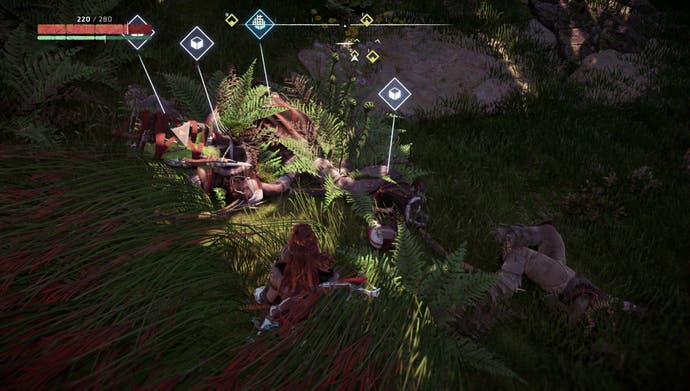
- Shadow distance: In close proximity, shadow filtering is of exceptional quality but the resolution of the shadow maps quickly dissipates just a few metres from the player character. The shadow cascade quickly jumps from highly detailed to amorphous blob shadow in a way that can prove distracting at times. In the larger open areas, this is never a real problem, but it stands out while exploring dense forests and areas with lots of complex shadow work. Still, we'll always trade shadow quality for increased performance so Guerrilla made the right choice here.
- Foliage interaction: You'll spend a lot of time traipsing grassy hills and dense forests and while the dense foliage looks beautiful, most of the plant life does not react to the player in any way. Instead of brushing up against these plants, the player simply clips right through them which looks a little off-putting next to the otherwise stunning animation work. As with shadow distance, however, this is likely a necessary trade-off in order to hit the target frame-rate.
- Minor glitches: As polished as Horizon may be, this is still an open world game and as such, strange things can happen. From ducks walking in mid-air and boars clipping right through a stack of crates to enemies that just disappear into a wall after death, there's no shortage of this stuff. Most of it is good fun and harmless to the overall experience at least, but it's worth pointing out as it does momentarily break the immersion the game world works so hard to generate.

Horizon Zero Dawn - the Digital Foundry verdict
Horizon Zero Dawn is an important - and successful - release for Guerrilla Games. While the Killzone games were always a sight to behold, the series played second fiddle to the more popular first-person shooter franchises. Shadow Fall sold exceptionally well by all accounts, but it didn't break through to establish the series as a contender against Call of Duty or Battlefield. By moving to a new genre and a different world, Horizon feels like a breath of fresh air. Its characters are immediately more engaging and the gameplay itself is more refined and exciting. And in terms of the core gameplay, the Dutch studio has a real winner on its hands.
As expected, Guerrilla's level of technical accomplishment is simply sensational. Its ability to produce striking visuals has never been in question but the Decima engine has reached new heights with Horizon. This is a powerful toolset that serves as a solid foundation for future games and one that is seemingly very flexible, bearing in mind what we've seen of the engine's utilisation in Killzone Shadow Fall and in Supermassive's Until Dawn - not to mention the hints of Death Stranding revealed thus far. An earlier Decima iteration even formed the base of Killzone Mercenary on PlayStation Vita, based on a PC-orientated OpenGL fork of the engine, no less.
Evolving that technology with little compromise to support the kind of expansive, richly detailed open world seen in Horizon Zero Dawn is not insignificant. And the level of scaling here is quite simply phenomenal - as you can see in our main analysis video above, the detail level isn't just about the epic vista shots. Engage photo mode and explore the immediate environment: the scaling extends to remarkable levels of detail right down to individual blades of grass. The Decima engine employs a GPU-based procedural generation technique, which we'll learn more about at GDC, responsible not just for this insane level of world creation, but also for audio, wildlife and even gameplay elements.
In conclusion, looking back over what works and what doesn't, it's clear that the major achievements in the former category far outweigh the more localised gripes of the latter. We're sure that in many cases, future updates could resolve issues like dialogue placement and camera issues, while random bugs and glitches are likely unavoidable in a title with the scale and scope of this one. That said, when you're engaged in a world as rich as this one, it's funny how even the most minor, silly bugs can impact the sense of immersion. But what's clear is that the level of technical ambition on display here sets new standards for the current generation of console gaming. There's a remarkable story to be told here, and we hope to bring you more on that soon.





